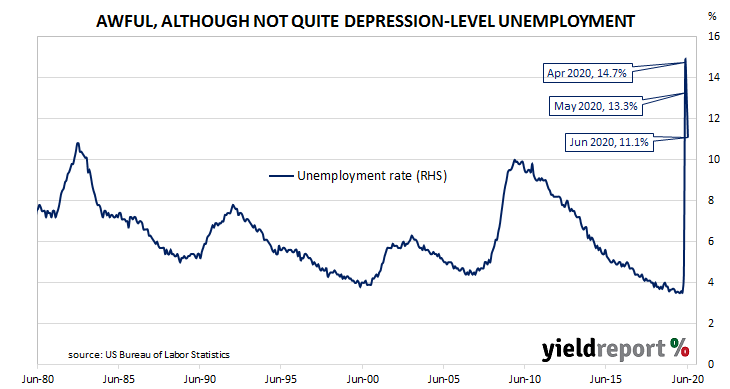Summary: June non-farm payrolls increase exceed gains in May; jobless rate down, participation rate up; US economy “getting back to work”; stalled openings, renewed restrictions may slow future recovery; underemployment rate lower but still high.
The US economy ceased producing jobs in net terms as infection controls began to be implemented in March. The unemployment rate had been around 3.5% but that changed as job losses began to surge through March and April. May’s non-farm employment report represented a turning point and economists expected something similar in June.
According to the US Bureau of Labor Statistics, the US economy created an additional 4.8 million jobs in the non-farm sector in June. The gain was above the 3.0 million which had been expected and more than the 2.699 million jobs which had been added in May after revisions. Employment figures for April and May were revised up by a total of 90,000.
June’s unemployment rate dropped from May’s revised rate of 13.3% to 11.1%. The total number of unemployed decreased by 3.235 million to 17.75 million while the total number of people who are either employed or looking for work increased by 1.705 million to 159.932 million. The increase in the number of people in the labour force raised the participation rate from May’s rate of 60.8% to 61.5%.
“The US labour market followed the lead of other data in June, showing the economy is getting back to work,” said ANZ economist Adelaide Timbrell.
Most US Treasury yields fell but they increased at the ultra-long end on the day. By the close of business, the US Treasury 2-year bond yield had lost 2bps to 0.15%, the 10-year yield had slipped 1bp to 0.67% while the 30-year yield finished 1bp higher at 1.43%.
Economists have been noting rising US infection rates in recent weeks after some restrictions had been eased. Timbrell noted “…July could see the recovery in jobs slow, given the recent rise in COVID19 cases, stalled re-openings and renewed restrictions in some states…There is still a long way to go.”
One figure which is indicative of the “spare capacity” of the US employment market is the employment-to-population ratio. This ratio is simply the number of people in work divided by the total US population. It hit a cyclical-low of 58.2 in October 2010 before slowly recovering to just above 61% in late-2019. June’s reading increased for a second consecutive month from 52.8% in May to 54.6%.

